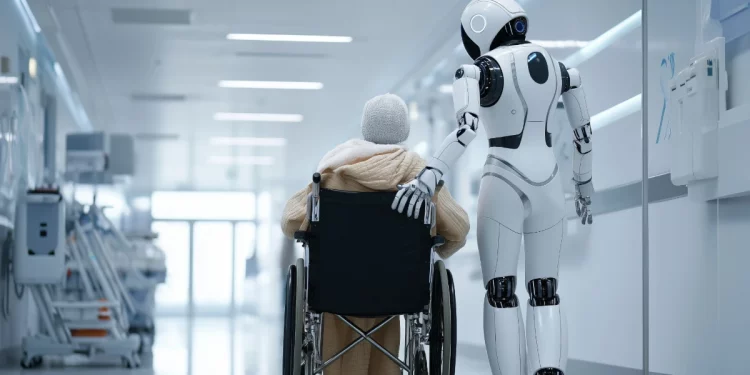Transforming Senior Care Through Intelligent Assistance
Senior care is undergoing a major technological transformation, with AI and robotics redefining the way aging populations receive support, companionship, and medical attention. These innovations are creating smarter, safer, and more responsive assisted living environments that enhance quality of life.
The biological process of aging brings a host of challenges—reduced mobility, cognitive decline, and chronic illness. However, the application of AI and robotics offers a natural path forward, blending technology with human empathy to create adaptive systems that nurture independence while ensuring safety.
From robotic companions that monitor emotional well-being to AI platforms that predict health issues before they occur, the future of assisted living is increasingly shaped by intelligent design and innovation.
AI in Senior Care: Personalized, Predictive, and Proactive
Artificial Intelligence is revolutionizing elder care through automation, data analysis, and predictive health management. Its ability to process vast data streams allows caregivers and families to make more informed, timely decisions.
1. Predictive Healthcare
AI systems can identify early signs of illness by analyzing vital data — from blood pressure and glucose levels to movement and sleep quality. By detecting anomalies, these systems provide natural interventions that prevent hospitalizations and extend lifespan.
2. Medication Management
Seniors often juggle multiple medications. AI-powered apps track prescriptions, remind users to take doses, and alert caregivers about missed schedules. This intelligent support ensures accuracy and reduces human error.
3. Cognitive and Emotional Support
AI-driven conversational agents and smart assistants engage seniors in dialogue, games, and mental exercises to prevent cognitive decline. These systems recognize voice tone and mood, responding with empathy and humor, which helps combat loneliness and depression in Aging populations.
4. Smart Environment Integration
AI integrates seamlessly with home automation—adjusting lighting, temperature, and security based on activity levels or time of day. Such intuitive systems foster independence while maintaining a biological rhythm that feels human and natural.
Robotics: Redefining Assisted Living
While AI processes and predicts, robotics brings physical functionality to senior care. Robots are no longer science fiction; they are caregivers, helpers, and companions designed to enhance safety and comfort.
1. Mobility and Rehabilitation Robots
For seniors with mobility challenges, robots assist with walking, standing, and exercising. Robotic exoskeletons replicate biological movements, aiding rehabilitation after surgery or injury. These machines adapt to the body’s natural mechanics, promoting balance and flexibility.
2. Caregiving Robots
Care robots help lift or transfer patients, reducing the physical burden on human caregivers. In countries like Japan, robots such as Robear safely assist with lifting patients from bed to wheelchair — preserving dignity while preventing caregiver injuries.
3. Companion Robots
Companion robots like PARO (a robotic seal) and ElliQ provide emotional comfort, responding to touch and voice. They are programmed to show empathy, reducing anxiety and loneliness among older adults. Studies show they have positive effects on mood and lifespan.
4. Service and Maintenance Robots
From delivering meals to disinfecting rooms, service robots ensure hygiene and efficiency in assisted living facilities. Their reliability supports a clean, safe environment — a foundation of healthy Aging.
AI and Robotics: A Symbiotic Relationship
The combination of AI and robotics represents a biological-like synergy — one processes data, the other executes physical action. Together, they form an adaptive ecosystem capable of understanding, learning, and responding to human needs.
AI provides real-time analytics, while robotics transforms insights into action. For instance, an AI system might detect a senior’s unsteady gait and instruct a robotic assistant to provide physical support. This natural coordination mimics the cooperation between the human brain and body.
The result? Assisted living that feels intuitive, efficient, and compassionate — technology that doesn’t replace humans but amplifies their ability to care.
Data, Privacy, and Ethical Responsibility
Integrating AI and robotics into senior care introduces complex ethical questions around data privacy, consent, and emotional authenticity. Seniors often rely on devices that continuously monitor their activity and health. Ensuring this data remains secure is essential.
To preserve dignity and trust, developers are prioritizing transparency and consent-based systems. Ethical AI ensures seniors understand what data is collected and how it is used, maintaining the natural balance between care and autonomy.
While technology can simulate empathy, genuine compassion remains a human trait. The ultimate goal is to create partnerships between caregivers and machines — a collaboration where technology supports human connection rather than replacing it.
The Economic and Global Impact of AI-Driven Care
With global populations aging rapidly, senior care costs are skyrocketing. AI and robotics offer scalable solutions that reduce strain on healthcare systems while enhancing service quality.
1. Efficiency and Cost Reduction
Automation reduces administrative burdens, saving both time and resources. Robots that clean, deliver meals, or assist with routine tasks free human staff for emotional and medical care.
2. Workforce Enhancement
Caregiving is a demanding profession with high turnover rates. Robots can fill critical labor gaps by performing repetitive or labor-intensive duties, allowing human caregivers to focus on meaningful interaction and medical supervision.
3. The “Green Revolution” of Healthcare
Just as irrigation and automation transformed agriculture during the Green Revolution, AI and robotics are ushering in a new “Care Revolution.” They are irrigating healthcare with technological innovation — sustaining human vitality and extending lifespan naturally.
This shift parallels the biological resilience of ecosystems, creating care systems that are adaptive, sustainable, and nurturing.
Emotional Intelligence and Humanized Robotics
Today’s robots are designed to sense emotions through facial recognition and tone analysis. They interpret micro-expressions, respond empathetically, and adapt conversation patterns accordingly.
This emotional intelligence allows robots to engage in natural interactions that make seniors feel heard and understood. When a resident expresses sadness, a companion robot might play calming music or initiate a conversation about positive memories — blending logic with empathy.
AI-powered companionship fosters belonging and reduces cognitive decline caused by isolation. It’s a biological necessity transformed through digital means — maintaining emotional wellness as part of holistic aging care.
Enhancing Lifespan and Preventive Care
AI’s predictive capabilities are not limited to treatment; they extend into prevention. By analyzing continuous health data, AI can detect early signs of disease and prompt timely intervention.
Wearables and sensors powered by AI offer seniors a digital safety net, reducing the risk of falls or unnoticed health deterioration. Robots, meanwhile, ensure medication adherence and assist in daily routines that support longevity.
These systems simulate a natural care cycle — observe, analyze, respond — mirroring how human caregivers operate, but with enhanced precision and 24/7 availability. The result is a longer, healthier lifespan supported by predictive care and continuous monitoring.
Robotics and Physical Therapy
Rehabilitation is crucial for maintaining independence among seniors, and robotics is leading the way.
- Exoskeletons assist seniors in walking after strokes or surgeries, restoring movement through biological muscle stimulation.
- Therapeutic robots guide seniors through gentle exercises, track progress, and adjust difficulty based on real-time AI feedback.
- Tele-rehab systems allow therapists to monitor sessions remotely, providing guidance through robotic or virtual tools.
This integrated approach creates a natural rehabilitation experience where recovery aligns with the body’s rhythm, promoting physical strength and confidence.
Social and Psychological Well-Being
Beyond physical health, AI and robotics address the social and emotional aspects of Aging. Isolation remains one of the biggest challenges in senior care.
Through robotic companions, AI chatbots, and virtual communities, seniors can stay connected with loved ones, participate in group activities, and continue learning new skills.
Some facilities are experimenting with immersive virtual experiences — enabling residents to “travel” or revisit cherished places through VR, stimulating memory and joy. AI curates these experiences, ensuring they align with each individual’s preferences and biological comfort.
By nurturing emotional connections, technology is extending not just lifespan, but life satisfaction — a natural and essential part of well-being.
Designing the Future of Assisted Living
The future of assisted living lies in blending innovation with empathy. Imagine a facility where:
- AI predicts medical risks weeks in advance.
- Robots prepare meals, assist with mobility, and initiate friendly conversations.
- Smart homes adjust lighting, temperature, and reminders automatically.
- Human caregivers focus on empathy, companionship, and decision-making.
This vision reflects the next phase of the Green Revolution — one not of crops and irrigation, but of care, compassion, and longevity. AI and robotics will not erase human touch; they will amplify it, ensuring every senior lives with safety, dignity, and purpose.
Through the natural harmony of biological design and digital innovation, the aging process transforms — not into decline, but into sustained vitality, where technology and humanity evolve together.









